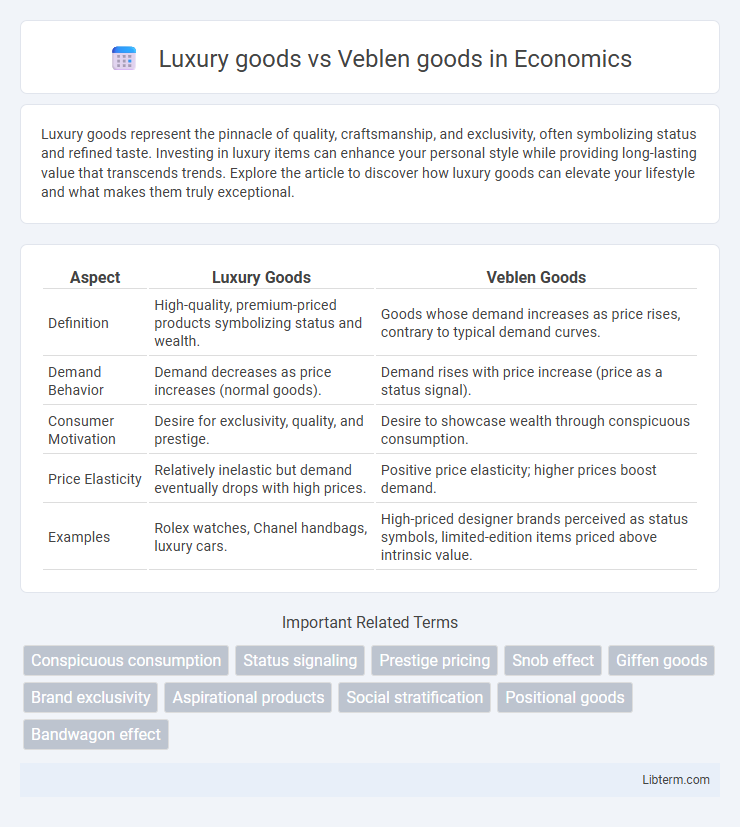Luxury goods represent the pinnacle of quality, craftsmanship, and exclusivity, often symbolizing status and refined taste. Investing in luxury items can enhance your personal style while providing long-lasting value that transcends trends. Explore the article to discover how luxury goods can elevate your lifestyle and what makes them truly exceptional.
Table of Comparison
| Aspect | Luxury Goods | Veblen Goods |
|---|---|---|
| Definition | High-quality, premium-priced products symbolizing status and wealth. | Goods whose demand increases as price rises, contrary to typical demand curves. |
| Demand Behavior | Demand decreases as price increases (normal goods). | Demand rises with price increase (price as a status signal). |
| Consumer Motivation | Desire for exclusivity, quality, and prestige. | Desire to showcase wealth through conspicuous consumption. |
| Price Elasticity | Relatively inelastic but demand eventually drops with high prices. | Positive price elasticity; higher prices boost demand. |
| Examples | Rolex watches, Chanel handbags, luxury cars. | High-priced designer brands perceived as status symbols, limited-edition items priced above intrinsic value. |
Understanding Luxury Goods: Definition and Characteristics
Luxury goods are products that signify high quality, exclusivity, and prestige, often associated with premium pricing and superior craftsmanship. These goods cater to affluent consumers seeking status and differentiation, characterized by brand heritage, limited availability, and exquisite design. Unlike Veblen goods, whose demand rises with price due to perceived social status, luxury goods emphasize intrinsic value and exceptional quality beyond mere price effects.
Veblen Goods Explained: Beyond Ordinary Luxury
Veblen goods represent a unique class of luxury goods whose demand escalates as their price increases, defying typical economic principles. These products serve as status symbols, where exclusivity and conspicuous consumption drive consumer behavior beyond functional utility. Unlike ordinary luxury goods, Veblen goods rely heavily on perceived social prestige, reinforcing their value through rarity and high cost.
Historical Evolution: Luxury vs Veblen Goods
Luxury goods have historically symbolized wealth and social status, often handcrafted with premium materials to signify exclusivity and craftsmanship. Veblen goods, a subset of luxury items, emerged conceptually in the late 19th century through economist Thorstein Veblen's theory of conspicuous consumption, where demand increases as prices rise due to their status signaling function. The historical evolution of luxury goods reflects shifts from material opulence to status-driven consumption, while Veblen goods specifically emphasize price as a key factor in consumer preference and social differentiation.
Psychological Drivers of Luxury Consumption
Luxury goods and Veblen goods both capitalize on status signaling and exclusivity, but Veblen goods distinctly gain higher demand as prices rise, driven by the psychological desire for conspicuous consumption and social distinction. The perception of rarity, craftsmanship, and brand heritage plays a pivotal role in luxury consumption, reinforcing self-identity and emotional gratification. Consumers are motivated by prestige and the aspiration to differentiate themselves, often valuing price as an indicator of quality and social rank in both categories.
The Veblen Effect: When Price Signals Status
The Veblen effect describes a phenomenon where higher prices increase the desirability of goods by signaling exclusivity and social status, contrasting with the typical demand curve where higher prices reduce demand. Luxury goods often exemplify this effect, as consumers perceive more expensive items as symbols of wealth and prestige, driving demand despite premium pricing. This status-driven demand highlights how Veblen goods blur the lines between utility and social signaling in market behavior.
Key Examples: Luxury Goods vs Iconic Veblen Goods
Luxury goods such as Rolex watches, Gucci handbags, and Hermes scarves symbolize refined craftsmanship and exclusivity, appealing primarily to status-conscious consumers seeking quality and prestige. Iconic Veblen goods like the Bugatti Chiron and Chanel's classic flap bag defy typical demand laws by increasing in desirability as prices rise, driven by their extravagance and conspicuous consumption value. Both categories emphasize rarity and high price points, but Veblen goods uniquely leverage price elevation to enhance their appeal as ultimate status symbols.
Price Elasticity and Consumer Behavior
Luxury goods exhibit moderate price elasticity, where demand fluctuates with price changes, reflecting consumers' desire for high-quality, status-enhancing products. Veblen goods demonstrate negative price elasticity, as higher prices increase their desirability and exclusivity, motivating consumers to purchase them as status symbols. Consumer behavior towards Veblen goods is driven by conspicuous consumption, contrasting with the more typical demand patterns seen in luxury goods.
Branding Strategies in the Luxury and Veblen Markets
Branding strategies for luxury goods emphasize exclusivity, heritage, and craftsmanship to create aspirational value and justify premium pricing. Veblen goods rely on conspicuous consumption, where branding highlights status signaling and social prestige to attract consumers willing to pay higher prices for visibility. Both markets deploy limited editions, influencer endorsements, and high-quality storytelling to strengthen perceived value and maintain desirability.
Current Market Trends Shaping Luxury and Veblen Goods
Current market trends reveal that luxury goods continue to grow through digital innovation and personalized customer experiences, enhancing brand exclusivity and consumer engagement. Veblen goods, driven by their status-symbol appeal, see increased demand from affluent millennials and Gen Z, who prioritize unique designs and social media visibility. Sustainability and ethical production are increasingly influencing purchasing decisions, reshaping traditional luxury and Veblen goods markets.
Future Outlook: The Blurring Lines Between Luxury and Veblen Goods
The future outlook for luxury goods and Veblen goods reveals a growing convergence, as both categories increasingly emphasize exclusivity, status, and premium pricing strategies that cater to affluent consumers seeking uniqueness. Innovations in digital marketing and personalized experiences are reshaping consumer perceptions, making traditional luxury brands adopt Veblen-like pricing tactics to maintain desirability and perceived value. This blurring of lines signals a market evolution where the distinction between luxury as a symbol of quality and Veblen goods as symbols of prestige continues to diminish, driven by consumer demand for both craftsmanship and conspicuous consumption.
Luxury goods Infographic

 libterm.com
libterm.com